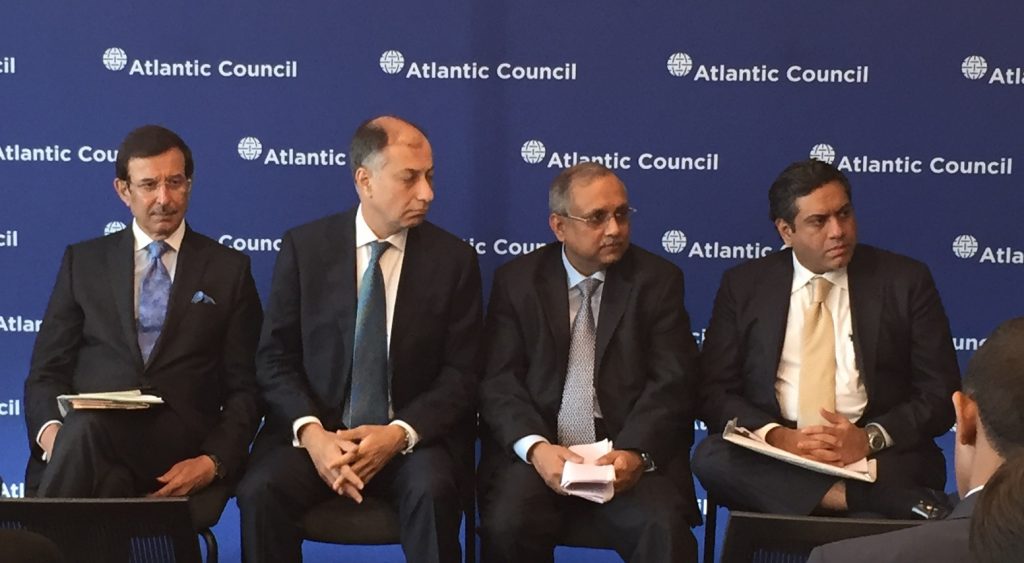On September 9, business leaders representing some of the largest industries in India’s private sector convened at the Atlantic Council to discuss the state of the Indian economy. A week after it was announced that the Indian economy grew by 7%—tying China as the world’s fastest growing economy—the titans of Indian business addressed the potential for further growth and the strides Prime Minister Narendra Modi has made in stimulating business. The South Asia Center orchestrated this event in partnership with the Confederation of Indian Industry (CII), a partner with whom the Center has paired for a Megacity Security Conference in Mumbai this November.
The panelists—including Dr. Naushad Forbes, Mr. Chandrajit Banerjee, Mr. Tarun Sawhney, Mr. Deep Kapuria, Dr. Rajiv Modi, Mr. Rajan Navani, and Mr. Rahul Munjal—lent their full support to the joint government initiative to raise bilateral trade from $100 to $500 billion over the next ten years between the United States and India. The United States and India have established a solid basis for security cooperation in the region, but a bourgeoning trade relationship has yet to materialize. As Bharath Gopalaswamy, Director of the Atlantic Council’s South Asia Center, noted in his introductory remarks, the US-India strategic dialogue must also be a commerce dialogue.
Modi campaigned on an economic platform with the promise to reenergize the Indian economy. Director of India’s leading steam engineering firm, Dr. Forbes remarked, “The government came in with huge expectations of change and economic development.” Modi has not accomplished the promised economic overhaul, but progress is evident in the “Make in India” campaign, and the ongoing battle to implement the Goods and Services tax. These measures could add a few percentage points to GDP growth in the years to come, Dr. Forbes concluded, as well as ensure economic vitality in the long term.
India’s economy remains in a rapid transition from agriculturally-driven to a highly technology-dependent manufacture-based economy. While improvements in the manufacturing industry have occurred at a rapid pace, other sectors have been been slower to adapt to the modern globalized economy. Mr. Forbes continued that “if the rest of the economy had the same growth as modern manufacturing, the economy would grow by a factor of twenty.” Technology co-development and coordination, the panelists agreed, will play a dominant role in the US-India trade relationship. The United States has the means and incentive to boost Indian manufacturing, and the panelists urged Modi to prioritize ¬¬¬technological innovation during his upcoming US visit. Modi has already set out on two initiatives, “Digital India” and “Smart Cities,” that necessitate US investment. Private US companies, Director General of CII Mr. Banerjee pointed out, may play a critical role in those initiatives, and similar opportunities for US companies will expand as India’s Foreign Direct Investment (FDI) caps increase.
The panelists also addressed possible roadblocks to further economic growth and cooperation with the United States. Indian noncompliance with US and international standards remain a thorn in the US-India relationship, particularly within the realms of Intellectual Property Rights (IPR), Foreign Direct Investment caps (FDI), and Trade Agreements. Despite progress in resolving these issues, Managing Director of India’s largest sugar manufacturer Mr. Sawhney perceptively noted, “What works in the United States probably will not work in India.”
After a lively discussion with the audience, Mr. Forbes concluded the conversation with a critique and recommendation on how to promote the US-India trade relationship in the future. “The thing that holds back India-US relations,” Mr. Forbes explained, “is that we expect the other country to be like some other country as opposed to being like ourselves. On India’s side, we expect the US to be like Japan. In Japan, the Government decides something and then it happens right away. That’s not how the US government works.” A similar expectation persists on the American side: “the US expects India to be like China. But we’re a noisy democracy, and the US is a noisy democracy!” In order to fulfill the potential in the US-India trade relationship, a recalibration of expectations must occur. “For the US to expect things to happen in India in a clean, organized way, is unreasonable. Politics is not always functional, but at the end of the day, progress is solid.”
